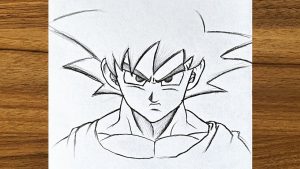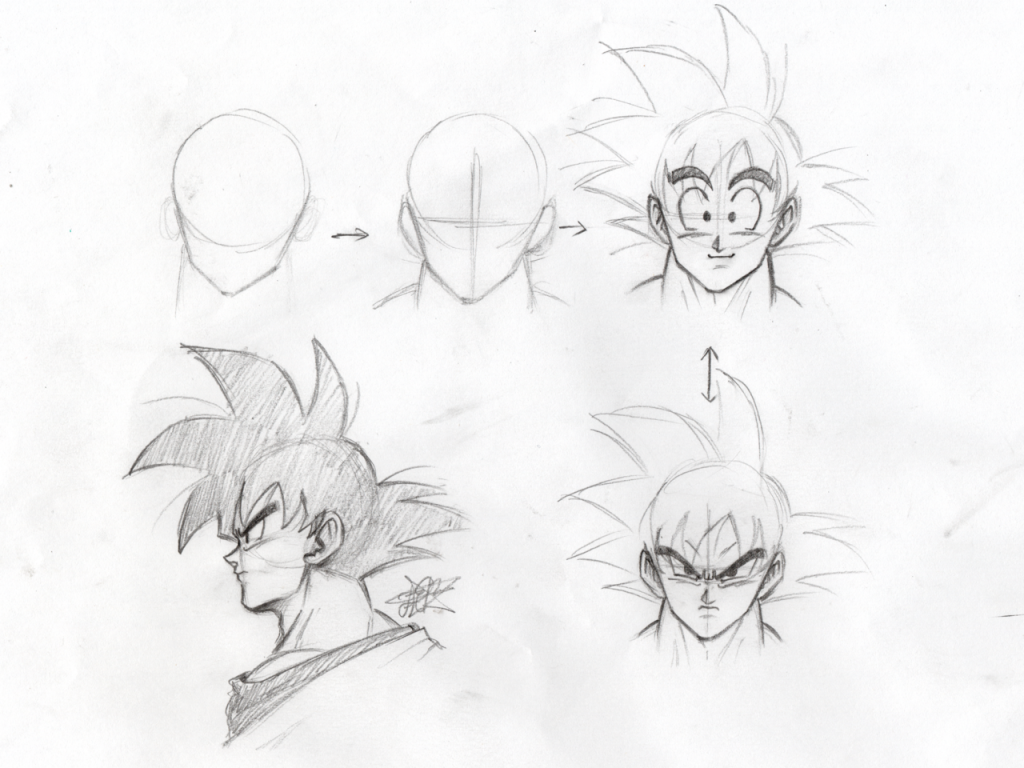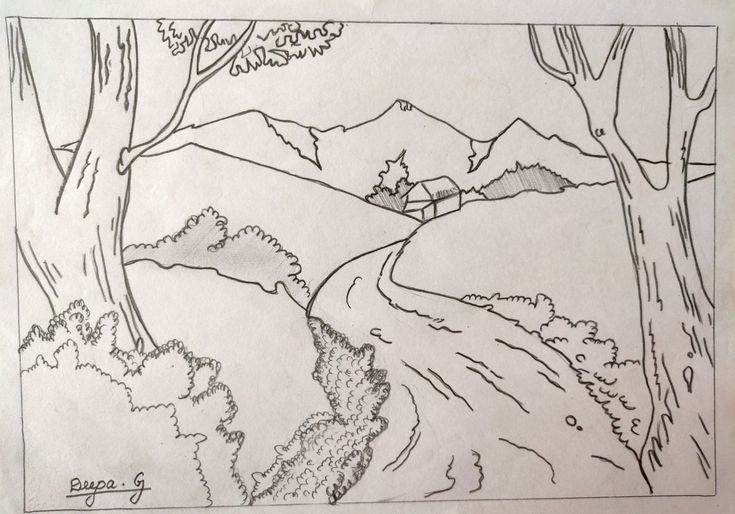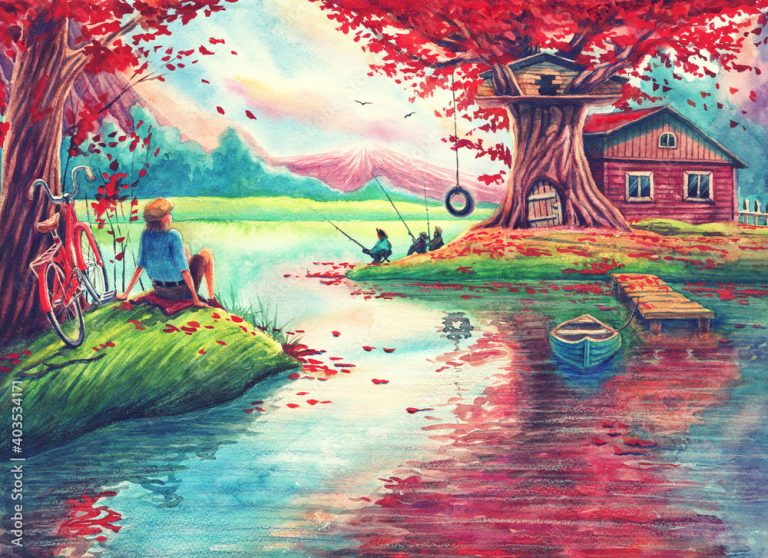Creating a Goku Drawing of Goku, the iconic protagonist from the Dragon Ball series, is an exciting venture for fans and artists alike. Begin by sketching Goku’s distinctive spiky hair, paying close attention to its unique shape and direction. Capture his determined expression with intense eyes and a confident smile. Outline Goku’s muscular physique, emphasizing the well-known orange and blue gi he wears during his adventures.
- A Guide to Drawing Goku
- The Journey of Creating a Goku Masterpiece
- Drawing Goku in True Akira Toriyama Style
- Drawing Goku and His Companions in Action
- Drawing Goku’s Transformations
- Fan Art Showcase Celebrating Dragon Ball’s Hero
- Exploring Pencil, Digital, and Watercolor Techniques
- Frequently Asked Questions (FAQs)

A Guide to Drawing Goku
Unleashing your inner Super Saiyan and Goku Drawing the one and only Goku can be exciting! Here’s a guide to help you capture his iconic features and dynamic poses:
1. Start with the basics:
- Head: Draw a circle for the head and mark lines for facial features. Goku’s eyes are large and slightly slanted, eyebrows are pronounced, and the chin is pointed.
- Body: A trapezoid shape can represent the torso, connected to a narrower cylinder for the legs. Use lines for arms and simple shapes for hands.
2. Master the details:
- Hair: Spiky and wild! Use jagged lines radiating from the crown, varying in length and thickness. Don’t forget the signature four spikes in front.
- Eyes: Sharp and intense. Draw irises with small black pupils and add white highlights for a piercing gaze.
3. Pose with power:
- Dynamic stances: Exaggerate his movements to show action. Use bending limbs, tilted bodies, and strong lines to convey energy.
- Fighting moves: Think Kamehameha blasts, flying kicks, and powerful punches. Reference scenes from the anime or manga for inspiration.
- Expressions: Let his emotions shine through! Fierce battle cries, determined grins, and moments of surprise can be captured through facial details and body language.
4. Level up your drawing:
- Shading and shadows: Add depth and dimension with shading. Use darker tones for muscle definition, creases in clothing, and under the hair.
- Coloring: Bring Goku to life with his signature orange and blue gi. Add yellow accents for hair and belt, and don’t forget the red wristbands.
- Backgrounds: Simple elements like clouds, rocky landscapes, or even the glow of a Kamehameha can enhance the scene.

The Journey of Creating a Goku Masterpiece
Creating a Goku Drawing masterpiece isn’t just about capturing his physical details, it’s about capturing his spirit, his journey, and the essence of Dragon Ball. Here’s how you can embark on this artistic adventure:
Conceptualize Your Goku:
- Defining Moment: Decide which version of Goku Drawing you want to depict. Is it the playful child exploring martial arts, the determined Super Saiyan battling Frieza, or the contemplative Mastered Ultra Instinct warrior?
- Inner Conflict: Show his internal struggle between power and compassion, discipline and humor. Consider the emotions driving his actions.
- Symbolism: Incorporate elements like the Dragon Balls, Kamehameha waves, or even the orange gi to amplify the iconic aspects of his universe.
Sketching the Foundation:
- Dynamic Stance: Don’t settle for a static pose. Use action lines, contorted limbs, and exaggerated muscles to portray his explosive power.
- Anatomy Mastery: Understand the underlying muscle structure and bone placement to achieve a believable, powerful physique.
Refine and Enhance:
- Shading and Light: Use light and shadow to sculpt his form, add depth to his muscles, and emphasize his presence in the scene.
- Controlled Chaos: Balance the wildness of his hair and aura with clean lines and defined forms to avoid overwhelming the viewer.
- Storytelling Background: Don’t leave him floating in a void! Create a setting that reflects the moment you’re portraying, be it a desolate battlefield or a serene training ground.
Mastering the Details:
- Spiky Perfection: Each hair in his iconic mane should be unique, adding texture and dynamism to his silhouette.
- Gi’s Flow: Use subtle wrinkles and folds to show the movement of his clothes and accentuate his powerful form.
- Aura’s Glow: Capture the energy radiating from him with vibrant colors and radiating lines, reflecting his emotional state.

Drawing Goku in True Akira Toriyama Style
Capturing the essence of Akira Toriyama’s iconic style when Goku Drawing is both challenging and rewarding. Here are some key tips to help you master it:
1. Embrace the Exaggerated Proportions:
- Toriyama’s characters are known for their large heads, expressive eyes, and elongated limbs. Don’t be afraid to stretch proportions. This adds dynamism and cartoonish appeal.
2. Master the Signature Hairstyle:
- Goku’s hair is a crucial element. Focus on spiky, irregular strands instead of perfectly symmetrical or smooth lines. Use short, jagged strokes to create a wild and untamed texture.
3. Simplify Muscle Definition:
- While Goku is undeniably powerful, Toriyama avoids overly complex muscle groups. Use a few bold lines to suggest muscles rather than meticulously sculpting them.
4. Play with Dynamic Poses:
- Toriyama’s characters are rarely static. Capture Goku in powerful action poses, with exaggerated movements and limbs bent at extreme angles. Think flying kicks, mid-air punches, and explosive energy bursts.
5. Focus on Expressive Eyes:
- Toriyama’s characters communicate a lot through their eyes. Master different expressions like intense focus, determined grit, playful grins, and even surprised blinks.
6. Utilize Simple Shading:
- Toriyama primarily uses crosshatching for shading. Practice this technique to add depth and dimension to Goku’s features and clothing without overcomplicating the picture.
7. Remember the “Speed Lines”:
- These short, swirling lines around Goku add a sense of movement and speed. Use them sparingly but effectively to emphasize powerful actions.

Drawing Goku and His Companions in Action
Drawing Goku and his companions in action can be a thrilling artistic challenge! Here are some tips to capture the energy and camaraderie of these iconic Dragon Ball characters:
1. Choose Your Battle Scene:
- Epic Clash: Will it be Goku and Vegeta teaming up against a powerful villain like Broly? Or perhaps Krillin and Gohan facing off against the Ginyu Force? Choose a scene that resonates with you and allows for dynamic group interactions.
- Training Montage: Show them pushing their limits, sweat flying, muscles straining. Include elements like gravity chambers, waterfalls, or rocky training grounds.
- Teamwork Moment: Highlight their unique abilities and how they complement each other. Use their signature moves and attacks to create a visually stunning scene.
2. Design the Composition:
- Balance the Action: Don’t let Goku dominate the scene. Distribute characters strategically, using leading lines and perspective to guide the viewer’s eye through the action.
- Foreground and Background: Use depth to create a sense of movement. Place closer characters in action poses and relegate others to the background for context.
3. Capture Individual Personalities:
- Goku: Fierce determination, playful grins, and explosive energy bursts.
- Vegeta: Arrogant confidence, intense focus, and hidden pride in his teammates.
- Krillin: Clever strategies, underdog spirit, and moments of comedic relief.
- Piccolo: Stoic wisdom, strategic planning, and flashes of unexpected humor.
4. Emphasize Movement and Power:
- Exaggerated Poses: Don’t be afraid to bend limbs at extreme angles, use dynamic lines for action, and show characters leaping, flying, and unleashing powerful attacks.
- Speed Lines: Use short, swirling lines around characters and attacks to add a sense of speed and blur.
- Explosions and Effects: Don’t forget the flashy energy blasts, ki auras, and impact effects that make Dragon Ball battles so visually exciting.
Drawing Goku's Transformations
Transforming into a Super Saiyan is one of the most exciting aspects of Goku’s character! Let’s explore how to capture these iconic transformations in your art:
1. Understanding the Different Forms:
- Super Saiyan: Start with the classic transformation. Golden spiky hair, sharp eyes with white irises, and an aura of golden lightning. Pay attention to subtle physical changes like sharper features and slightly enlarged muscles.
- Super Saiyan 2: Sharper aura, electric sparks, more defined muscles, and even spikier hair. Experiment with a wider, angry grin or intense focus in the eyes.
- Super Saiyan 3: Long flowing golden hair, even more defined muscles, and a powerful, almost regal aura. This form can be challenging to draw, so focus on emphasizing the flowing hair and imposing presence.
- Super Saiyan God: Slimmer build, crimson hair and eyes, and a calm, focused aura with a reddish hue. Pay attention to the contrast between the calm expression and the powerful aura.
2. Capturing the Transformation Moment:
- Energy Buildup: Show Goku powering up, veins popping, muscles tensing, and electricity crackling around him. Use dynamic lines and shading to emphasize the intensity of the moment.
- Hair Explosion: Draw the sudden burst of golden or blue hair in dramatic fashion. Use jagged lines and varying thickness to show the wildness of the transformation.
- Aura Flare: Depict the aura erupting outwards, filling the frame with vibrant colors and energy lines. This symbolizes the immense power unleashed.
3. Differentiating Each Form:
- Color Grading: Use different shades of gold and blue to distinguish between transformations. Consider adding subtle red hues for Super Saiyan 3 and God.
- Muscle Definition: Subtly increase muscle mass and definition as the transformations progress.
- Expression and Aura: Play with the intensity and focus of the eyes, and tailor the aura’s shape and size to each form.
Fan Art Showcase Celebrating Dragon Ball's Hero
To celebrate Dragon Ball’s hero, let’s dive into a vibrant showcase of fan art honoring Goku! Imagine an art exhibit bursting with creativity, where each piece captures a different facet of our Saiyan powerhouse:
1. The Dynamic Warrior:
- Fierce Battles: Goku locked in epic clashes with iconic villains like Frieza, Broly, or Cell. Imagine explosions shaking the canvas, energy blasts scorching the background, and muscles straining with every punch.
- Training Montage: Sweaty determination etched on Goku’s face as he pushes his limits in gravity chambers, scales waterfalls, or spars with Vegeta under the scorching sun. Every stroke conveys the relentless pursuit of strength.
- Mastered Ultra Itinct: A serene yet powerful Goku, bathed in a soft silver glow, deflecting attacks with effortless grace. The art exudes an aura of tranquility amidst unimaginable power.
2. The Compelling Hero:
- Goofy Grin and Playful Spirit: Capture Goku’s infectious laughter as he shares a meal with friends, trains with Chi-Chi, or races Krillin in a friendly challenge. Let the art radiate warmth and camaraderie.
- Moments of Compassion: Depict Goku reaching out to a fallen opponent, offering food to a starving enemy, or teaching Gohan the value of protecting the innocent. These scenes highlight his boundless empathy.
3. The Artistic Spectrum:
- Classic Manga Style: Bold lines, dramatic shading, and exaggerated expressions reminiscent of Akira Toriyama’s iconic panels. Imagine Goku leaping across the page, surrounded by speed lines and explosive energy.
- Realistic Renderings: A hyper-detailed Goku, muscles sculpted with anatomical precision, hair glistening with every strand, and a fierce gaze piercing through the viewer. This style offers a gritty, grounded take on the Saiyan hero.
- Abstract Interpretations: Goku’s essence captured through swirling brushstrokes, vibrant color palettes, and unconventional shapes. This approach delves into the emotional core of the character, using symbolism and metaphor to evoke his spirit.
Beyond the Canvas:
- Sculptures: A towering Goku statue crafted from bronze, capturing his indomitable spirit and powerful physique. Imagine every vein and muscle ripple with the potential for explosive power.
- Cosplay Ensembles: Goku brought to life by talented cosplayers, meticulously replicating his iconic costumes and poses. The passion and dedication of these fans shine through every detail.
Exploring Pencil, Digital, and Watercolor Techniques
Delving into the world of art can be exciting, and choosing between pencil, digital, and watercolor can feel like a daunting first step. But worry not, intrepid artist! Let’s explore the unique charms and challenges of each medium to help you find your artistic soulmate:
Pencil:
- Classic Appeal: The timeless feel of graphite on paper, the satisfying scratch of lead, and the subtle gradations of grey lend themselves to realistic renderings, delicate sketches, and expressive crosshatching.
- Accessibility: Pencils are readily available, affordable, and portable, making them perfect for on-the-go sketching and experimentation.
- Learning Curve: While mastering shading and blending takes practice, it offers a tactile and intuitive connection to your artwork.
- Challenges: Achieving vibrant colors or dramatic lighting effects can be tricky with pencils alone. Erasing can leave visible marks, and layering too much can lead to smudging.
Digital:
- Versatility Unbound: Paint like watercolor, sketch like pencil, sculpt like clay – digital art offers boundless possibilities with brush textures, color palettes, and special effects at your fingertips.
- Undo Button is your Friend: Experiment without fear! Mistakes can be easily erased, and adjustments are a breeze, allowing for a more fluid and iterative creative process.
- Technology Dependence: You’ll need a computer and drawing tablet, which can be an investment. Learning specific software takes time, and relying on technology can sometimes feel impersonal.
- Eye Strain: Staring at screens for extended periods can be tiresome. Take breaks and prioritize eye health while enjoying the digital playground.
Frequently Asked Questions (FAQs)
- Start with simple shapes: Begin by sketching basic shapes like circles, ovals, and rectangles to represent the head, torso, and limbs. This will help you build a foundation for your drawing before adding details.
- Pay attention to proportions: The proportions of a girl’s body are generally different from those of a boy. For example, the head is typically larger in proportion to the body, and the waist is narrower than the hips.
- Oversexualization: Avoid drawing girls in overtly suggestive poses or clothing. Focus on capturing their personality and individuality rather than their physical attributes.
- Clichés and stereotypes: Don’t fall into clichés like damsels in distress or overly bubbly princesses. Be creative and explore diverse representations of girls.
- Art books and tutorials: There are many great books and online tutorials available that can teach you how to draw girls in different styles. Look for resources specifically focused on female figure drawing or character design.
- Online communities: Join online communities or forums for artists who draw girls. This is a great way to get feedback on your work, learn from others, and stay inspired.




















